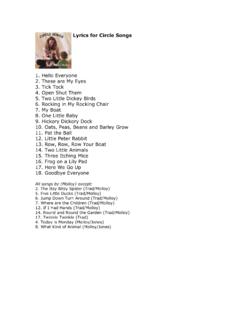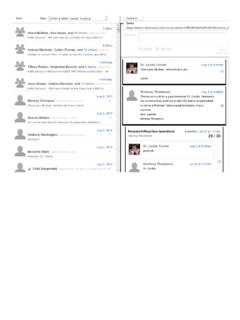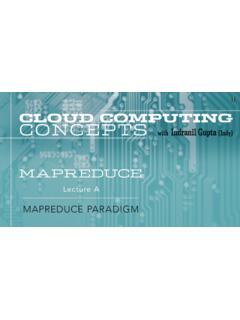Transcription of Hema Subramanian Hello, everyone and welcome to the US …
1 Hema Subramanian hello , everyone and welcome to the US EPA's webcast on the final National Pollutant Discharge Elimination System or NPDES Pesticide General Permit. This presentation will focus upon the filing of notices of intent also known as NOIs under the PGP. And this is a repeat of the webcast that was given on March 1st although some topics covered today may expand a bit upon those that were covered on March 1st. Thank you for joining us. We are going to give a few minutes for folks to join in. But in the meantime, I will go over some housekeeping matters. If you experience trouble with viewing or hearing the presentation, just check that your setup meets the system requirements for using Go-To Webinar that was listed in your invitation and confirmation e-mail. You may also check with your network administrator to make sure they don't have any firewalls. We've heard in the past that attendees have had some success by logging out and logging back in. On the right side of your screen, you will see a dashboard, which can be expanded.
2 You can send us an instant message through that dashboard and we will monitor if there appear to be widespread difficulties. All attendees will be muted for the duration of the webcast but we will be able to see comments and questions that you send in through the dashboard feature on the right side of your screen. Just so you know, this webcast is being recorded and an archived version will be posted to the PGP training's website with a copy of the PowerPoint, audio and transcripts within two weeks. It takes a couple of weeks just so that we can format everything to be posted onto the web. Today's presentation will be formatted as follows. We will have a PowerPoint presentation given by me, Hema Subramanian and then Prasad Chumble with Jack Faulk assisting with questions. We will pause at points to read aloud some of the popular questions that have come in. Although we won't be able to get all questions taken on the air, we will try to answer some directly through the messaging feature and we will keep a record of all of your questions to help make our future presentations, outreach documents, and a Q&A document we are developing more useful.
3 We will try to be as responsive as possible in addressing the issues that we hear need clarifications regarding the PGP. There will also be some polls in this webcast where you will be able to give a sure input and we will read aloud the results live on the air. These polls will also help us in how we discuss the items that are in the webcast. At the end of the webcast as you are leaving there will also be a survey, which will be really helpful for us if you could fill out. Again today's topic is on notices of intent under the PGP. This is just one topic we are planning to feature in a series of webcasts. We previously hosted two webcasts on the general background of NPDES permitting of pesticides and EPA's PGP and the archive of that general broadcast is located on the PGP. website. If you click on trainings and meetings on the right side menu of that's the trainings website. Then you can just click on pesticides under training resources-webcast and that presentation has an archived copy and that website.
4 Today's presentation is intended for audiences who are already familiar with the basics of PGP and are in a geographic area covered by EPA's PGP and who are eligible for the PGP. We will present briefly some background however, we would strongly recommend that you view the archive of the previous presentation on the general NPDES of pesticide discharges prior to today's webcast if you have not already. And today and again today's archive will be posted to the web within two weeks. So with that let's begin. Today we are going to cover several topics regarding NOIs. Just a moment. First, we will cover some background and then we will cover what is an NOI. We will cover who must submit an NOI. The timing of NOI submissions, what is included in an NOI and finally how to submit an NOI. Just to cover some background, in 2006 EPA published a rule, which clarified EPA's long-standing interpretation that discharges from pesticide applications did not require NPDES permit coverage. EPA was subsequently sued on that rule and lost.
5 As a result of the 2009 decision by the US Sixth Circuit Court of Appeals, The National Cotton Council et al versus EPA the determination that point source discharges of biological pesticides and chemical pesticides that leave a residue are pollutants under the Clean Water Act. These discharges therefore, need to be covered under an NPDES permit. On October 31st, 2011, EPA issued its final Pesticide General Permit that provides a mechanism for certain dischargers to comply with this new requirement. There are areas where EPA is the NPDES permitting authority. As you can see on your screen, EPA covers all discharges including from federal facilities from six states. Those states are Alaska, Idaho, Massachusetts, New Hampshire, New Mexico and Oklahoma. EPA also covers the discharges solely for oil and gas and geothermal related discharges in Texas. And the EPA covers discharges in Washington DC and all territories except the Virginia Islands and most tribal lands across the country.
6 In all other states, EPA does not issue the permits. There are 44 states that are authorized to issue their own permits as well as the Virgin Islands. In four of those 44 states, Colorado, Delaware, Vermont and Washington, EPA. does issue the permit for federal facilities. And for Indian Country Lands EPA issues the permits for all of them except those in Maine. There is something to note here. Alaska and Oklahoma while EPA issues the permits currently for those states, the state environmental agencies will be taking over the pesticide discharge permitting in Alaska it will be phased in however. In Oklahoma the state DEQ is authorized for NPDES permits but not to regulate pesticide activity. And just to expand a bit on federal facilities a bit because there seems to have been some confusion lately. Essentially EPA permits all the discharges in the six states and the territories that I just mentioned however the states permit the discharges for all discharges except the federal facilities in 4 states that I just noted.
7 In those 4 states, EPA will issue the permits for the federal facilities. The federal facilities are more of an acting party rather than a geographic or physical place. There may be pesticide applications made by private parties or state governments on federal lands, for example. And the federal agency in these cases may not have any involvement in those activities. In such cases, those pesticide applications may need permit coverage to be issued by the state permitting authority. Conversely there may be private lands where a federal agency manages that. If a federal agency is making decisions regarding the pesticide treatments on an area then the area treated may be considered a federal facility. So in Colorado, Delaware, Vermont and Washington, EPA would issue the permits for these federal activities. One way to look at this is to look at who the decision-maker is. If the decision-maker is a federal agency, then the EPA may issue the permits for those activities within those 4 states.
8 We will go a bit more into what decision-makers are in just a moment. But in states that are not covered by EPA, states will issue general permits and individual permits and those permits must meet all Clean Water Act requirements that the federally issued permit must meet but they can be more stringent. A. directory of state NPDES agencies is available on the EPA PGP website at the link that appears on your screen. Now we are going to pause for moment and just take a poll. Our first poll is under which permits will your discharges be covered. Based on the information I just presented, do you believe that your discharges would be covered under EPA's permit, a state permit, both EPA and state permits, neither or are you unsure? And so now we will open -- the poll should be open and when we get a good critical mass of responses I will read aloud what the responses were. Just a moment. We have about two-thirds of the responses in and 42% believe that you would be covered under EPA's permit.
9 Now you should be able to actually see the results on your screen actually. About 30% of you feel that you will be covered under a state permit, 22% of you feel that you will be under both an EPA and a state permit, 1% say neither and about 5% of you are unsure. Just to reiterate if you are going to be covered under a state agency permit, you may wish to go to the state agency's website or contact your state agency to find out the requirements that are specific to your permitting because the information covered today will only address the NOI requirements for EPA's Pesticide General Permit. Just to go over the types of NPDES permits that are available. There are individual permits and there are general permits. You may have heard both of those terms used before. Individual permits come into play when one application is submitted and one permit is issued. A single permit will be written specific to that one permitee. However, general permits there is one permit that is issued and many NOIs are submitted by many permitees so a single permit is written for a class of permitees.
10 EPA expects the majority of discharges from pesticide applications to be covered under general permits. Without a general permit entities applying pesticides would need to obtain individual permits in order to legally discharge pesticides to waters of the US under the Clean Water Act and individual permits are typically a bit more burdensome in terms of time for both the operator and the agency. So as you can see, general permits like the PGP are intended to reduce burdens. Regarding the scope of EPA's Pesticide General Permit, our general permit covers point source discharges to waters of the US from the application of biological pesticides and chemical pesticides that leave a residue. The PGP. covers the following four use patterns: mosquitoes and other flying insect pests, weed and algae, animal pests, forest canopy pests. Very important to note, agricultural run-off and irrigation return flow continue to be exempt under the Clean Water Act and do not require a permit. Other stormwater discharges containing pesticides will only require a permit to the extent that these discharges require permit coverage independent of the Sixth Circuit Court decision.



















